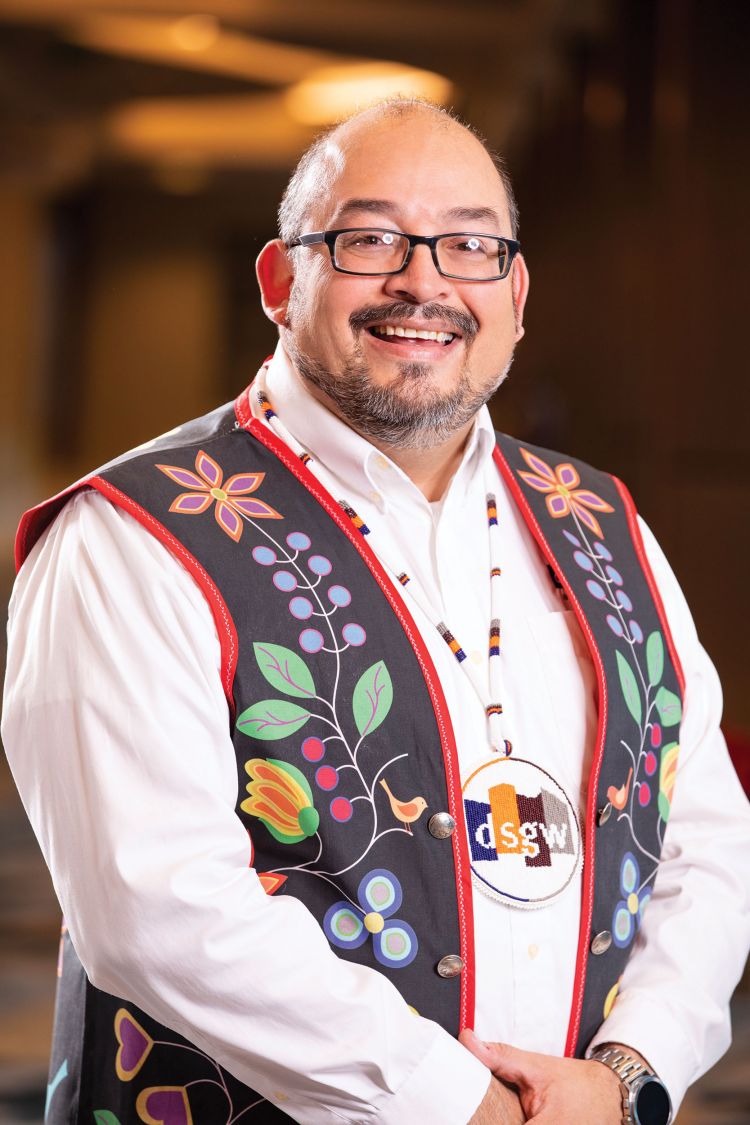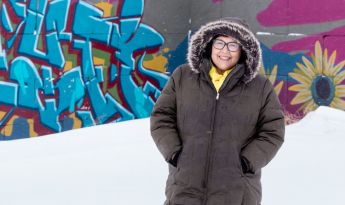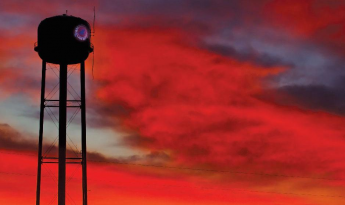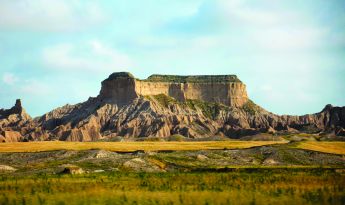Rebuilding for the Future
Native Governance Center reflects on the first decade of its Native Nation Rebuilders program and the work ahead
by Art Coulson, Cherokee Nation of Oklahoma
profiles by Lauren Kramer, Native Governance Center external and donor relations officer
Illustrations by Marlena Myles
Ten years. Twenty-three Native nations. One hundred seventy-six Tribal citizens trained in innovative governance practices, leadership skills and nation building.
But the decade-old Native Nation Rebuilders program is about more than numbers.
“It’s a 176-person-strong family,” says Jayme Davis (Turtle Mountain/Standing Rock), program director at Native Governance Center, the Native-led nonprofit that oversees this leadership development program. Davis is also a Cohort 7 Rebuilder.
"The program is rooted in nation building, culturally-grounded leadership skills and data from 40 years of research on Indigenous economic development."
Wayne L. Ducheneaux II (Cheyenne River Sioux Tribe), Native Governance Center executive director and a Cohort 3 Rebuilder
“There are many other Native leadership programs, but the Rebuilders program is unique because of its specific focus on governance,” says Wayne L. Ducheneaux II (Cheyenne River Sioux Tribe), Native Governance Center executive director and a Cohort 3 Rebuilder. “The program is rooted in nation building, culturally-grounded leadership skills and data from 40 years of research on Indigenous economic development. Native leaders from all different sectors become Rebuilders and use what they learn to make a positive impact on their communities.”
Each Rebuilders cohort is a two-year experience that inspires and invests in Tribal citizens as they develop knowledge, hone leadership skills and build connections. The program centers on nation building, a set of strategies that Native nations can use to strengthen their governments and overall quality of life for Tribal citizens. Year one consists of four in-person sessions incorporating leadership development exercises and the core principles of nation building. In year two, Rebuilders develop and execute a nation-building project that benefits their home communities. These projects span a wide range of focus areas and can include everything from social entrepreneurship to developing training programs for Tribal citizens to working with youth.
And, participants say, the investment of the Rebuilders program pays off when they return home to replant seeds of good governance, strategic thinking and innovation. “We run for office for the right reasons — wanting to make our sovereign nations better — but the tools that are typically used are based off that old ‘standard approach,’” says Jamie Azure, Tribal chairman of the Turtle Mountain Band of Chippewa and a Cohort 9 Rebuilder. “The Rebuilders program shows that there is a better way — a strategic, planful way to lead.”
Rebuilders come together to discuss common issues and challenges. They share strategies, success stories, best practices and case studies of related situations from Tribes across the U.S. and Canada. In the end, they come away with a framework for leadership that focuses on the long term and includes strategic tools to overcome obstacles.
The Rebuilders program’s emphasis on long-term thinking with a cultural lens helps elected leaders, but it can also assist Tribal nonprofit professionals, educators, entrepreneurs and others.
"Whether you’re in a nonprofit, the education sector, or are an entrepreneur, the characteristics of what makes a nation successful can apply to your organization. It’s a mindset."
Pearl Walker-Swaney (Standing Rock/White Earth), Rebuilders program manager and a Cohort 7 Rebuilder
“We focus on more than just a framework for governance,” says Pearl Walker-Swaney (Standing Rock/White Earth), Rebuilders program manager and a Cohort 7 Rebuilder. “Whether you’re in a nonprofit, the education sector, or are an entrepreneur, the characteristics of what makes a nation successful can apply to your organization. It’s a mindset. Having a strategy to positively impact future generations is important, and we all need to be aware and engaged as Tribal citizens of our nations.”
Native Governance Center, the Bush Foundation and Bowman Performance Consulting recently completed an evaluation survey of more than 120 Rebuilders from the program’s first 10 years. Walker-Swaney says several findings are evident from the enthusiastic stories shared by participants. “They’re inspired that there is a framework, that there is a different way of governing that works,” she says. “There is something out there that matches who we are as a people, is innovative, long-term and sustainable.”
Dr. Twyla Baker, chair of the Native Governance Center board and a Cohort 2 Rebuilder from the Mandan, Hidatsa and Arikara Nation, says the program has become essential in today’s polarized political climate. “We have to be forward-thinking. We have to focus on what the next iteration of Indian Country looks like and prepare for more challenges.”
The Native Nation Rebuilders program originally grew out of conversations between the Bush Foundation and Tribal leaders from the 23 Native nations that share geography with Minnesota, North Dakota and South Dakota. To strengthen their nations’ sovereignty, Tribal leaders said their citizens needed more leadership tools. The Rebuilders program was launched in 2010, and since 2016 has been run independently by Native staff members at Native Governance Center.
“We believe, and the research shows, that strong Tribal governance leads to strong Tribal nations,” says Ducheneaux. “Ultimately, our program helps strengthen Tribal sovereignty by supporting grassroots Native changemakers.”
The 176 Rebuilders trained over the past 10 years are driving changes in their communities by creating nonprofits, opening schools, establishing language revitalization programs, running for Tribal council and pursuing elected roles in state government.
“The value of being surrounded by like-minded people cannot be measured. Going into a cohort of strangers from many other Tribes in session one, then leaving session four considering those same strangers as family is a feeling I cannot describe,” says Chairman Azure. “Knowing that even though we are all extremely busy in our professional lives, we can still reach out to any of our ‘family’ and get an almost instant response is calming.”
Baker shared a similar sentiment from her experience in the program. “We’re able to collaborate, support each other and sometimes even commiserate,” she says. “I can think of scads of Rebuilders who have skill sets that I can tap into for advice, or who I can just lean on — folks to support the work that I do.”
As the program enters its second decade, Native Governance Center plans to refine the Rebuilders curriculum piece by piece to ensure that it maintains a strong focus on shared values and cultural practices, while acknowledging the unique beliefs, leadership styles and histories of different nations. There will be more nation-building case studies from the 23 Tribal nations it serves, rather than relying on success stories from Native nations in other regions of the U.S. and Canada. The new curriculum will begin to roll out this fall, Davis says.
"...apply your Tribe’s uniqueness, build strong teams that will live longer than yourself, and just keep moving forward to that better tomorrow."
Jamie Azure, Tribal chairman of the Turtle Mountain Band of Chippewa and a Cohort 9 Rebuilder
Rebuilders, board members and staff also plan to further Indigenize the Rebuilders curriculum by taking a holistic approach to learning nation building, including additional time for health or movement breaks, reflection and prayer. Program staff are also working directly with Tribal youth to launch a Youth Rebuilders program for Tribal citizens between the ages of 14 and 24.
While Tribes outside of Native Governance Center’s 23-nation service area have expressed interest in the program, Davis says there is a lot more work to do within this region before any expansion.
“No one ever said that rebuilding nations would be easy and without failures,” Chairman Azure says. “Take the lessons and assets that are provided, apply your Tribe’s uniqueness, build strong teams that will live longer than yourself, and just keep moving forward to that better tomorrow.”

Native Nation Rebuilders 2009-2019
10 Cohorts: 176 Native Nation Rebuilders from 22 of the 23 Native Nations in Minnesota, North Dakota & South Dakota.
97% said the Rebuilders curriculum was empowering to them.
94% said the program helped them be a more effective leader in their community.
94% said the program helped them design, lead and effectively implement nation-building efforts in their communities.
90% have supported an increase in their community’s use of Tribal sovereignty for community initiatives and programs.
87% have supported the strengthening of their community’s capacity to use more effective self-governance practices.
Data based upon 120 survey respondents representing all 10 cohorts and 12 Native Nations.
Rebecca Crooks-Stratton:
Building Strong Partnerships
Rebecca Crooks-Stratton, a Cohort 2 Rebuilder, believes that community engagement and accountability lie at the heart of successful leadership. Now in her second term as secretary/treasurer for the Shakopee Mdewakanton Sioux Community (SMSC), Crooks-Stratton keeps her fellow Tribal citizens informed about what’s happening at the governmental level and instills confidence in SMSC’s policies and systems. She is part of the three-person SMSC Business Council, which oversees the day-to-day operations of SMSC’s Tribal government and its 4,000 employees. In addition, the Business Council builds strategic partnerships with local, state and federal governmental entities.
Growing up in a political family fostered Crooks-Stratton’s early interest in Tribal politics. Since childhood, she has played an active role in her community. Crooks-Stratton feels extremely grateful for all of the support that she’s received from the Shakopee Mdewakanton Sioux Community over the years. Her desire to give back guides her leadership. She explains, “Our Community has provided me with so many opportunities. There was never a question that I wanted to take what I’ve learned and give back to my community, in a way similar to how my elders gave back to me.”

Photo courtesy of Shakopee Mdewakanton Sioux Community
One of the many ways that Crooks-Stratton gives back is through her leadership of the Understand Native Minnesota initiative. Launched in October 2019, Understand Native Minnesota is a three-year, $5 million strategic campaign that seeks to improve public attitudes toward, and knowledge of, Native Americans. The Shakopee Mdewakanton Sioux Community created the campaign to transform Minnesota’s K-12 school curriculums to better reflect the history, modern-day realities and contributions of Native people.
Building partnerships with non-Tribal entities as a member of SMSC’s Business Council fueled Crooks-Stratton’s passion for Understand Native Minnesota. “Multiple groups can’t work together in the best interest of the greater community unless they truly understand each other. Having that basic level of education about who Tribes are gives our partners a better knowledge of where we are now.”
The recently completed, multimillion-dollar water treatment plant opened by the Shakopee Mdewakanton Sioux Community in partnership with the city of Prior Lake is an example of a successful partnership fueled by mutual understanding, Crooks-Stratton says. “Twenty years ago, that never would’ve been possible,” she adds. While the treatment plant is a start, her hope is that Understand Native Minnesota’s work leads to additional sustainable and money-saving partnerships between Tribal and non-Tribal governments, among other positive impacts.
Between her work, family and community, the busy Crooks-Stratton credits the Native Nation Rebuilders program’s training for helping her stay grounded. The program gave her a better understanding of who she is, what her priorities are and how she can bring others along to get projects done. In addition, she cites the support network that she built with her fellow Rebuilders as a source of strength and inspiration for her own leadership. “You gain a lot of resources when you’re in the program,” she says. “And it’s not just through the programming. It’s the people that are on the journey with you.”
Michael Laverdure:
Indigenizing Architecture

Photo by TJ Turner
For Cohort 10 Rebuilder Michael Laverdure (Turtle Mountain Band of Chippewa), an Indigenous mindset is a key component of good architecture. He’s a partner at DSGW Architects in Lake Elmo, Minnesota and the president of Native-owned planning firm First American Design Studio. Since joining DSGW back in 2008, Laverdure has focused entirely on Tribal projects. He designs structures that align with Native values and community members’ future goals and visions.
Just the second Native American student to graduate from the North Dakota State University School of Architecture, Laverdure grew up sketching his dream home and excelling in science and art. At his first firm in Grand Forks, he worked on non-Tribal projects across the country, but joining DSGW Architects unlocked his true passion.
“I started working with Tribes, and that’s where I had a renaissance with my architectural soul,” Laverdure explains. “I was practicing tenets of nation building without knowing it. I started participating in the process of planning and long-term visioning, and understanding what sovereignty means through architecture. It became a passion for me.”
The Rebuilders curriculum has given Laverdure a new language to incorporate future thinking, an emphasis on quality and deliberate community input into his business. For example, the curriculum seeks to avoid “standard approach” leadership that’s non-strategic and focused solely on short-term concerns. In architecture, rushing to build a standard, pre-engineered metal building instead of emphasizing long-term quality poses similar risks. “A lot of times, I’ll get a call from a Tribal council member or someone, and they’ll say, ‘You know, I need to get re-elected. And I want to build my pet project in time so I can campaign on it.’ That’s the standard approach. I’ve heard it a million times…But now I have words, and I have examples to show them how it works.”
In addition to the Rebuilders program, Laverdure credits his mother for demonstrating important Indigenous values that have helped him succeed. He approaches tasks with a strong heart and spirit, and he thoughtfully incorporates site blessings, prayer and other Indigenous concepts into the design process. “I say that we like our buildings to be like elders: they create an environment of subsistence. Subsistence is defined as acting upon something
to keep it new. And renewing it,” Laverdure explains.
"We like our buildings to be like elders: they create an environment of subsistence. Subsistence is defined as acting upon something to keep it new. And renewing it."
Michael Laverdure
Laverdure says he can count all of the Native architects he knows on his fingers (and maybe on a few toes, too), so he encourages more young Native people to pursue architectural careers. “Having a Native architect on your team is a force multiplier in cultural match,” he says. “We can make sure that a building isn’t patronizing to a Native person. Like an appropriation of slapping an Indian headband on a building and saying it’s Native. Because that’s not it. Being a warrior for your people and ensuring that architecture responds to your culture — that’s why Native kids need to be architects.”
Within the next five years, Laverdure hopes to write another book and finish developing an Indigenous certification process with colleagues at the American Indian Council of Architects and Engineers. He notes that no current building certification categories talk about culture. “If you have a project that was Indigenously conceived, designed, built and constructed, we’ll certify your building as Indigenous,” he explains. “It’s pretty ambitious. But it’s going to be one of a kind.”


